For Marc Schöneich, CEO of INNOCISE, a company pioneering a gripping system, his goal is to look beyond understanding and addressing fundamental science and move it toward application. Schöneich has always found an idea worthless unless it brings value as a product. The science comes alive for him when an idea is implemented and value is captured in engineering or industry.
Throughout his education, Schöneich was driven to dive deeper, get his hands dirty, and experiment not for experiment’s sake but to answer the essential question: “What can you do with it?” So it’s no surprise that after he earned his doctoral degrees, he branched out to change the way complex materials are gripped and released—in a more productive and energy-efficient way.
Scholar and disruptor
Schöneich started as a curious and stellar student. He pursued materials science as an undergraduate and was drawn to plastics and polymers. He wanted to research, experiment, and create more unique material solutions, so he continued his studies in both Germany and France, obtaining two Ph.D.s. As a materials science student, he often encountered friction when experimenting not only with the materials themselves but with potential applications. Modeling was king at the time and teams he worked with never seemed too worried about applications. But he jokes that friction makes heat, and heat was his motivation to combine research and application.
Upon graduation, as an expert in polymer materials and a plastic processing engineer, Schöneich got a job offer at a large corporation, but felt stifled right from the interview. He could tell the opportunities to innovate were limited and regimented.
This was a pivotal moment in his career. He decided he wanted to work somewhere where he would be free to explore, which led him to the Leibniz Institute for New Materials (INM), a leading international research institution in the field of materials research. Without an opening advertised, Schöneich reached out and explained his background and offered to provide his expertise on plastics projects. He received a call 10 minutes later inviting him for an interview the next day—and the rest is history.
Learning and recreating from the grip of a gecko
Schöneich joined INM in 2017. At the time, the team had more than a decade of high-level, award-winning scientific research emulating the gecko adhesion effect. He and his team will tell you geckos are amazing: They can climb the steepest walls (of any texture—wet, rough, slippery) and walk upside down on a ceiling. Geckos use adhesion forces that exist from tiny hairs on their feet and the surface they’re navigating. This is the van der Waals interaction, intermolecular interactions that occur between two polarizable molecules.
Schöneich’s job at INM was a dream for him: to find applications for this research. For two years, he traveled the world, assessed, and refined products that applied the gecko adhesion effect, aligned with interested companies, and discovered the need to spin out from INM and create a new company that could bring this technology to industry. This was the birth of INNOCISE.
The INNOCISE difference
As Schöneich worked, he found hurdles to overcome; you cannot simply copy nature. Nature is always ahead of and more advanced than human development. The best we can do is try to understand nature and appropriately re-engineer the effects. This is what INNOCISE does: it reengineers the adhesion technique and tailors it to specific applications. Schöneich’s main outlook of “what can it do?” has shifted slightly to “what do you need to do with it?”
This approach is core to the INNOCISE business model. They find ways to integrate and customize the technology into a customer’s process. The result is the development of many different grippers (sometimes tailor-made) of special polymers that can be integrated into different automation units with varying handling needs in both micro- and macro-handling.
For instance, grippers are often used in the fingertip of a robot. Robots handling microscopic components in optics, photonics, and electronics do especially well with INNOCISE grippers, because Schöneich and his team noticed these sensitive parts require care and precision, but traditional handling methods often break or damage pieces with gripping that is too forceful or leaves a residue. These observations led to the micro-handling arm of the business.
Schöneich also noticed a need for macro-handling. Traditional compressed air suctioning leads to a loss of energy. Engineering with this in mind, INNOCISE designed grippers for production plants to handle large but demanding components that are uneven in shape or are sensitive materials, such as automotive batteries or fuel cell components.
Thanks to Schöneich’s eye on application, new grippers continue to emerge as demand arises and the company evolves.
Going gecko green
INNOCISE’s grippers are changing the manufacturing landscape to be more sustainable. Because their grippers hold components without vacuum, magnetism, or pneumatics, the energy needed to grip is significantly reduced, and so is its CO2 footprint and noise emission.
Robots and assembly parts still need to move, but Schöneich is very conscious about how they are created and where they end up at the end of their lifecycle. Similar to a bottle-and-coin return, INNOCISE encourages customers to recycle the plastic parts into an ejection modeling machine to be reused.
Advice for up-and-comers
Schöneich made a mark for himself and INNOCISE by remaining curious and identifying ways to solve problems by watching natural elements at play. His career was formed through a confidence in ideas and following them.
His first piece of advice for other scientists and engineers looking to make their mark? Never lose sight of the application. Always keep the end goal, customer, and business case in mind. At the same time, he also encourages young leaders not to be afraid of mistakes; he firmly believes failure helps guide your path forward.
And perhaps the hardest lesson for Schöneich? Everything takes time and will not go as fast or smoothly as desired. He says to keep trying because if the passion and drive are there, the results will come.
What’s next?
Schöneich has never been driven by money, titles, or prestige. He simply wants to create something great and useful. He learned that to do so, he needs a strong team. This has resulted in a wonderful company culture, and Schöneich says the best days at INNOCISE are when the team is happy with themselves, their efforts, and their outcomes. This is the key: A happy team and positive company spirit.
About the Author
Jose Pozo
Chief Technology Officer, Optica
Jose Pozo joined Optica in March 2022, and has spent more than 25 years working in photonics. He earned a PhD in quantum physics from the University of Bristol (U.K.), and an M.Sc. and B.Eng. in telecom engineering from UPNA, Spain / VUB (Belgium). Prior to joining the European Photonics Industry Consortium (EPIC) in 2015 as CTO, Jose was a Senior Photonics Technology Consultant with PNO Consultants, with some of the main accounts such as CERN, Thales, and TE Connectivity. He has worked at TNO, The Netherlands Organization for Applied Scientific Research, and as a postdoctoral researcher at the Eindhoven University of Technology in the Netherlands, where he contributed to the early development of EFFECT Photonics.

